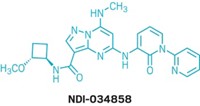Advertisement
Grab your lab coat. Let's get started
Welcome!
Welcome!
Create an account below to get 6 C&EN articles per month, receive newsletters and more - all free.
It seems this is your first time logging in online. Please enter the following information to continue.
As an ACS member you automatically get access to this site. All we need is few more details to create your reading experience.
Not you? Sign in with a different account.
Not you? Sign in with a different account.
ERROR 1
ERROR 1
ERROR 2
ERROR 2
ERROR 2
ERROR 2
ERROR 2
Password and Confirm password must match.
If you have an ACS member number, please enter it here so we can link this account to your membership. (optional)
ERROR 2
ACS values your privacy. By submitting your information, you are gaining access to C&EN and subscribing to our weekly newsletter. We use the information you provide to make your reading experience better, and we will never sell your data to third party members.
Business
Gilead buys Nimbus’s NASH portfolio
$400 million deal adds ACC inhibitors to Gilead’s liver disease pipeline
by Lisa M. Jarvis
April 6, 2016
| A version of this story appeared in
Volume 94, Issue 15
In a bid to strengthen its liver disease drug pipeline, Gilead Sciences will pay $400 million up front for Nimbus Therapeutics’ small molecules for nonalcoholic steatohepatitis (NASH), a liver disease that can lead to cirrhosis.
Currently, no drugs exist to treat NASH, which begins with fat deposits in the liver and can cause scar tissue to accumulate. Up to 5% of Americans have NASH and another 10–20% have fat in their liver, according to the National Institutes of Health.
With the deal, Gilead gets Nimbus’s allosteric inhibitors of acetyl-CoA carboxylase (ACC), an enzyme critical in fatty acid synthesis. Other companies—most recently Pfizer—have tried to develop drugs that block the activity of ACC, but their compounds have not been potent enough.
Those earlier molecules were intended to block the enzyme’s active site, a shallow, hydrophobic pocket that is a chemist’s “worst nightmare,” says Nimbus CEO Don Nicholson.
Nimbus took a different tack. The natural product soraphen A was known to slow the growth of yeast by nestling into an allosteric site on the enzyme. Working with its computational chemistry partner Schrödinger, Nimbus designed molecules that had the properties and interactions of the unwieldy natural product “but with the structure of a proper drug,” Nicholson says.
The virtual ACC inhibitors were then synthesized and improved upon by Nimbus chemists. Within 18 months, the biotech firm had an allosteric ACC inhibitor ready to be put into human studies.
Gilead is getting Nimbus’s lead drug candidate NDI-010976, which is poised to enter Phase II studies, and a series of follow-on compounds. Over time, Nimbus could earn another $800 million in milestone payments from Gilead as those assets wind through the clinic.
Gilead’s NASH portfolio already includes two treatments in Phase II studies—the LOXL2 inhibitor simtuzumab and the ASK1 inhibitor GS-4997—and an FXR agonist in Phase I that came through its acquisition of Phenex Pharmaceuticals.





Join the conversation
Contact the reporter
Submit a Letter to the Editor for publication
Engage with us on Twitter